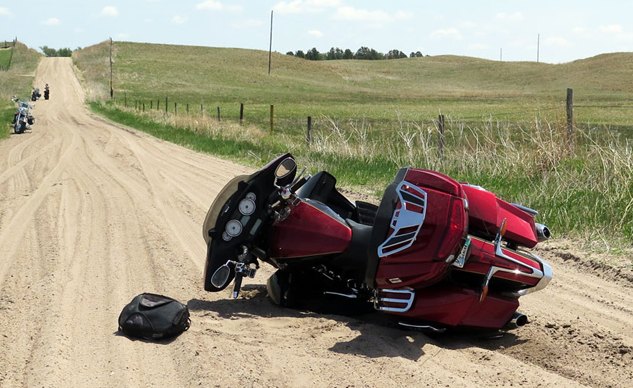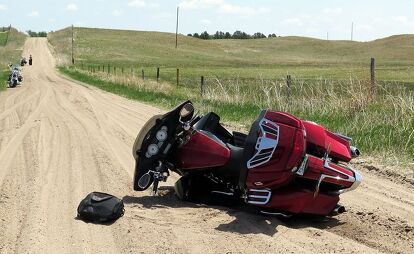Trizzle's Take – Taking A Digger

What we can take away from a crash
While all of us at MO clearly like to wrangle the latest and greatest motorcycles, you might be surprised to learn that a larger percentage of our time is spent in a chair (or standing desk in my case), staring intently at a computer screen, typing away as quickly as our little fingers will go. It’s not glamorous, nor is it nearly as much fun as riding, but hey, the site doesn’t run itself.
Like some of you, I hit the gym after work to relieve some stress, unwind, and of course, to get a good workout in (especially important if I want to fit in my leathers!). Recently, after I had finished my workout, I started talking with some of the other members as we were getting our things. As small talk usually goes, the topic turned to our professions, and upon hearing what I do for a living, one of my fellow gym-goers approached me.
“Did you know that 90% of motorcycle accidents occur in the person’s first year of riding?” she said to me. “So don’t be one of those people.”
I contemplated what she said for a second, not sure where her statistic came from, but instead of contesting her claim I simply said “too late.” I acknowledged her concern for my safety while gently letting her know that I’ve been on two wheels for quite some time now and have the scars to prove it. She surprisingly didn’t give me “The Talk” about why I shouldn’t ride motorcycles but, instead, simply wished for my continued safety when I ride.
This whole conversation got me thinking again about my outlook on crashes. Clearly, the best thing to do is not to crash at all; however, not all of us are that fortunate. Still, I think there are lessons to be learned from hitting the deck. My outlook is this: if I can clearly explain the reason behind the crash – which, more often than not, is rider error – then I’ve learned what not to do in the future.
I feel the same whether on the street or track. Analyzing a street crash can help us understand how to handle certain situations more effectively, while closely dissecting a crash on track could help us learn a technique to going faster. Sure, there could always be forces at play that are out of our control, but it’s up to us to do everything we can to keep ourselves alive.
As an example for analyzing a street crash, I remember a time I was riding a Honda CBR1000RR home from dinner one night. I had failed to account for the dew on the ground, which wasn’t there when I arrived only a few hours earlier. As I left the restaurant parking lot and attempted to merge with traffic, I instead gave too much throttle, spun the rear wheel on a paint line and highsided myself at 10 mph. Embarassing? Yes. Haunting? No. Thankfully traffic was light that night, but I broke the clip-on off and had to truck the bike back the next morning. What did I learn? To be conscious of changing riding conditions at all times, respect the bike’s power and, if the bike has it, crank the TC up for street riding.
Some of you might remember my experience racing at Pikes Peak in 2013, where I tucked the front and flew off the embankment while chasing my teammate in practice. Thankfully, I came away with only a broken foot. It meant I couldn’t walk, but the consequences could have been much worse. Thing is, I knew exactly what I did wrong. This might sound strange to some, but knowing the error of my ways is the reason this crash didn’t bother me (and, you know, the reality I wasn’t too badly injured). In fact, competing in the race two days later was exactly the redemption I needed. Sure enough, when I encountered the corner again, I didn’t follow the same line I had before and made it all the way to the top. Those crashes aren’t the ones that keep me up at night. It’s the ones I can’t explain that haunt me.
What still eats at me is a time I tucked the front while testing in the canyons. We had been doing several passes up and down one of our favorite roads, but this particular time, rounding a left-hand bend, the front simply went away from me. Two riders ahead of me went down at the same spot, so I assumed there was something slick on the road. Upon further inspection, however, the pavement was completely clean. That fall ate at me long after it was all over. To this day I still can’t explain what happened, but, for me anyway, the cure for getting over my angst was to get back in the saddle.
This is the internal dilemma I face when speaking to non-riders – some of whom are convinced motorcycles are death traps. They don’t understand why I ride and especially why I continue to ride after a fall. Personally, I enjoy the process of becoming increasingly proficient on a motorcycle, knowing there will always be more to learn.
Motorcycles don’t crash themselves. They simply follow the operator’s commands, and when those commands defy the laws of physics, you fall down. It’s not that our sport isn’t dangerous – I’d be foolish to ignore the inherent dangers – but we all have an acceptable amount of risk we’re willing to take. The goal is always to stay upright, of course, but as strange as it may sound, an occasional, relatively benign crash is instant verification on whether your technique worked or not. Learn from it, keep the lesson in your arsenal and you will also be on your way to becoming a more proficient rider.

Troy's been riding motorcycles and writing about them since 2006, getting his start at Rider Magazine. From there, he moved to Sport Rider Magazine before finally landing at Motorcycle.com in 2011. A lifelong gearhead who didn't fully immerse himself in motorcycles until his teenage years, Troy's interests have always been in technology, performance, and going fast. Naturally, racing was the perfect avenue to combine all three. Troy has been racing nearly as long as he's been riding and has competed at the AMA national level. He's also won multiple club races throughout the country, culminating in a Utah Sport Bike Association championship in 2011. He has been invited as a guest instructor for the Yamaha Champions Riding School, and when he's not out riding, he's either wrenching on bikes or watching MotoGP.
More by Troy Siahaan







































Comments
Join the conversation
I learned one thing last year - remember the kill switch is an option. Cost was relatively small but it was a lucky result. I would have saved myself from several weeks of sore ribs had I hit the switch.
My last crash was in 1979. My son and I were making a left turn at a city intersection when the rear tire started shifting left and right. At first I thought it had gone flat, but I was unable to keep the bike upright. It laid down on its right side and it, me, and my son slid about 35 feet until we hit the curb. The police were there in an instant and, as we tried to get the bike upright, we discovered something on the road surface had caused the blacktop to start dissolving and become VERY slippery - we could hardly stand up. Just then another man and his son came around the same corner on their bike and quickly went down too. About this time, cars started sliding sideways so we all headed for the safety of the sidewalk. There were no serious injuries, and minimal damage to the bikes, other than scraped side covers and mufflers. Lesson learned - you can never be sure of the road surface 100% of the time. To this day, I don't know what I could have done differently, so I encourage everyone to wear all the safety gear they can afford. BTW, my son is now grown and has bikes of his own. I still own the '77 Honda 750A (plus a '02 Goldwing and '13 Harley Heritage). Hopefully the "Crash of 79" will be the last. Ride safe.